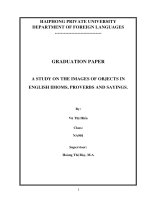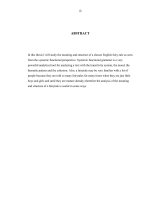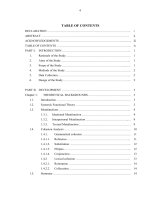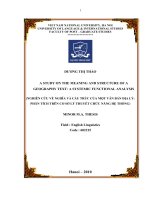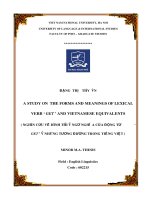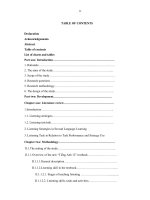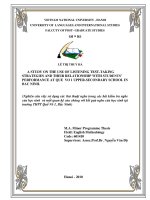A study on the aspects of syntax and semantics of negation in english and the contrastive analysis in vietnamese
Bạn đang xem bản rút gọn của tài liệu. Xem và tải ngay bản đầy đủ của tài liệu tại đây (474.28 KB, 51 trang )
Bộ giáo dục và đào tạo
Tr-ờng đại học dân lập hảI phòng
ISO 9001:2008
Khóa luận tốt nghiệp
NGàNH: ngoại ngữ
HảI phòng 2010
1
HAI PHONG PRIVATE UNIVERSITY
FOREIGN LANGUAGE DEPARTMENT
----------------- ------------
GRADUATION PAPER
A STUDY ON The a Spect S of Synta and
Semantic S of negation in engli Sh and
the contra Stive analy Si S in vietname Se
BY
Doan Hoang Giang
CLASS
NA 1003
SUPERVISOR
MRS Nguyen Thi Hoa, M.A.
HAIPHONG - 2010
2
Bộ giáo dục và đào tạo
Tr-ờng đại học dân lập hảI phòng
Nhiệm vụ đề tài tốt nghiệp
Sinh viờn: Mó s: ………………………..
Lớp: …………………………………………Ngành: ……………………….
Tên đề tài: …………………………………………………………………....
………………………………………………………………………………..
…………………………………………………………………………………
3
Nhiệm vụ đề tài
1. Nội dung và các yêu cầu cần giải quyết trong nhiệm vụ đề tài tốt
nghiệp (về lý luận, thực tiễn, các số liệu cần tính tốn và bản vẽ)
…………………………………………………………………………………
…………………………………………………………………………………
…………………………………………………………………………………
…………………………………………………………………………………
…………………………………………………………………………………
…………………………………………………………………………………
…………………………………………………………………………………
…………………………………………………………………………………
……………………
2. Các số liệu cần thiết để thiết kế tính tốn
…………………………………………………………………………………
…………………………………………………………………………………
…………………………………………………………………………………
…………………………………………………………………………………
…………………………………………………………………………………
…………………………………………………………………………………
…………………………………………………………………………………
…………………………………………………………………………………
…………………..
3. Địa điểm thực tập:
…………………………………………………………………………………
…………………………………………………………………………………
…………………………………………………………………………………
……..
4
CÁN BỘ HƯỚNG DẪN ĐỀ TÀI TỐT NGHIỆP
Người hướng dẫn thứ nhất:
Họ và tên:……………………………………………………………
Học hàm, học vị:……………………………………………………
Cơ quan công tác:…………………………………………………..
Nội dung hướng dẫn:……………………………………………….
Người hướng dẫn thứ hai:
Họ và tên:…………………………………………………………..
Học hàm, học vị:……………………………………………………
Cơ quan công tác:…………………………………………………..
Nội dung hướng dẫn:………………………………………………
Đề tài tốt nghiệp được giao ngày……tháng ….. năm 2010
Yêu cầu phải hoàn thành trước ngày……tháng …..năm 2010
Đã nhận nhiệm vụ Đ.T.T.N
Đã giao nhiệm vụ:
Đ.T.T.N
Người hướng dẫn
Sinh viên
Hải Phòng, ngày……tháng…...năm 2010
Hiệu trưởng
GS.TS.NGƯT. Trần Hữu Nghị
5
PHẦN NHẬN XÉT TÓM TẮT CỦA CÁN BỘ HƯỚNG DẪN
1. Tình thần thái độ của sinh viên trong quá trình làm đề tài tốt nghiệp:
...................................................................................................................
...................................................................................................................
...................................................................................................................
...................................................................................................................
...................................................................................................................
...................................................................................................................
..............................
2. Đánh giá chất lượng của khóa luận (so với nội dung, yêu cầu đã đề ra
trong nhiệm vụ Đ.T.T.N trên các mặt lý luận, thực tiễn, tính tốn số
liệu...)
...................................................................................................................
...................................................................................................................
...................................................................................................................
...................................................................................................................
...................................................................................................................
...................................................................................................................
..............................
3. Cho điểm của cán bộ hướng dẫn (điểm ghi bằng số và chữ)
...................................................................................................................
...................................................................................................................
...................................................................................................................
..............
Hải Phòng, ngày …..tháng…..năm 2010
Cán bộ hướng dẫn chính
6
(Họ tên và chữ kí)
NHẬN XÉT ĐÁNH GIÁ
CỦA CÁN BỘ CHẤM PHẢN BIỆN ĐỀ TÀI TỐT NGHIỆP
1. Đánh giá chất lượng đề tài tốt nghiệp về các mặt thu thập và phân tích tài
liệu, số liệu ban đầu, giá trị lý luận và thực tiễn đề tài.
…………………………………………………………………………………
…………………………………………………………………………………
…………………………………………………………………………………
…………………………………………………………………………………
…………………………………………………………………………………
…………………………………………………………………………………
…………………………………………………………………………………
…………………………………………………………………………………
…………………………………………………………………………………
………………………………………………
2. Cho điểm của cán bộ phản biện:
(điểm ghi bằng số và chữ)
Ng ày…..th áng…..n ăm 2010
Người chấm phản biện
7
ACKNOWLEDGEMENTS
First, I would like to express my deep gratitude to my dear supervisor,
Mrs. Nguyen Thi Hoa, for her whole-hearted help in terms of materials,
guiding and commenting. Moreover, her enthusiasm, inspiration and great
efforts to explain and introduce everything clearly and simply helped me
complete my graduation paper successfully.
Secondly, I am grateful to Foreign Language Department of Haiphong
Private University for giving me a chance to do this graduation paper.
Then, my thanks would also go to all teachers at the faculty for their
valuable lectures and useful experiences during the time I have been studying
here.
I finally wish to express my thanks to all members of my family and
friends for their unwavering supports to help me do this paper effectively.
HaiPhong, June 2010
Doan Hoang Giang
8
TABLE OF CONTENTS
Acknowledgments
Contents
Part A. Introduction ………………………………………………
1
1. Rationale ……………………………………………………
1
2. Aims of the study ……………………………………………
1
3. Method of the study …………………………………………
2
4. Scope of the study……………………………………………
2
5. Design of the study…………………………………………
2
Part B. Development…………………………………………………
4
Chapter I. Literature Review…………………………………….
4
1. Syntax and semantics………………………………………
4
1.1. An overview of syntax…………………………………………...
4
1.2. An overview of semantics ……………………………………….
5
1.3. Relation between semantics and syntax…………………………..
6
2. Classification of negation in English and Vietnamese………………..
7
2.1. Classification of negation …………………………………………
7
2.2. What is scope of negation…………………………………………
9
3. Contrastive analysis in learning a foreign language…………….. . .
9,10
4. Summary………………………………………………………………..10
Chapter II. Syntactic and semantic features of negation in English and
their equivalents in Vietnamese……………………………………….
12
1. Comparison between English and Vietnamese negatives in terms of their
syntactic features ……………………………………………………………12
1.1 Negative word not and its contracted form n’t………… ……….
13
1.1.1. Auxiliary negation…………………………………………..
13
1.1.2. Subject negation………………………………………….
14
1.1.3. Object negation ………………………………………….
15
1.1.4. Adverbial negation ………………………………………
16
9
1.1.5. Clausal ellipsis negation …………………………………
17
1.2. No negation ...…………………………………………………
17
1.2.1. Subject negation…………………………………………...
18
1.2.2. Subject negation with indefinite pronoun…………………….
18
1.2.3. Object negation with indefinite pronoun ……………… ….
19
1.3. Never negation……………….……..……………………………
19
1.3.1. Adverb negation with never.………………………............
19
1.3.2. Prepositional negation……………………………… …….
20
1.4. Transferred negation …………………………………………….
21
1.5. Negative form with too + adj/adv + to V-inf ……………………
22
1.6. Negative form with affixation………………………………… …. 22
2. Comparison between English and Vietnamese negatives in terms of their
semantic features……………………………………………………..
24
2.1. Word negative in meaning but not in form ……………………
24
2.1.1. Implicit negation …………………………………………..........
24
2.1.2. Adverbs of frequency …………………………………......……
25
2.1.3. Negation with few/little …………………………………….......
26
2.2. Double negation ………………….……………………………....
27
2.3. Question negation………………………………………………....
27
2.3.1. Tag – question .............………………………………..…..........
28
2.3.2. Wh- question ………………………………………… ……......
28
3. Summary ………………………………………………………………
29
Chapter III. Application of syntactic and semantic features of negation
in the text of President Barack Obama’s inaugural address ………… 30
1. In terms of its syntax…………………………………………………..... 31
1.1. Never negation ……………………………………………………....... 31
1.2. Not negation………………………………………………………….... 32
1.3. Affixation negation……………………………………………………..32
1.4. No negation…………………………………………………………......32
1.5.Negation with structure too adj/adv + to V-inf……………………....... 33
10
2. In terms of its semantics…………………………………………………..33
2.1. Implicit negation……………………………………… …………. ….. 34
2.2. Negation with few, little……………………………………………….. 34
2.3 Negation with adverbial of frequency……………................................ 34
3.Summary ……………………………………………………………….... 35
Part C. Conclusion ……………………..………………………………… 36
Abbreviation……………………………………………………………….. 38
References.....................................................................................................3940
11
INTRODUCTION
-----***----1. Rationale
Grammar is a large and important category in learning language,
especially in studying English. In modern concepts, grammar may be defined
as a set of morphological and syntactic rule which may be treated together to
make it easier for the learners of language to master and apply to real
situations. Being an ESL student, one may find many difficulties as well as
ambiguity when learning negation, one of important aspect of English
grammar, which can be appeared in every form of texts of many fields as well
as in daily conversation. It is said to be a natural phenomena in linguistic.
However, there is a wide variety of morphological and syntactic rules that
linguists have studied on this category with different point of view for
decades.
In Vietnamese, negation is also considered as an essential category in
grammar. Many studies were pointed out to clear and complete this matter.
However, it is difficult for Vietnamese learners to study negation in English
because there was little contrast between two languages. That the reason why
the topic of negation is chosen for this graduation paper.
It is expected that the syntactic and semantic features of negation in
English and their Vietnamese equivalents found in this graduation paper will
be helpful for learners in their studying.
2. Aims of the study
With the rationale above, this graduation paper is aimed at:
- Making a brief preview of theory of syntax and semantics and giving
an overview of syntactic and semantic features of negation in both
English and Vietnamese.
12
- Studying negation in terms of its structures and semantics and finding
out the similarities and differences between English and Vietnamese.
- Applying the findings of negation in a typical text, the text of President
Barack Obama’s inaugural address.
3. Scope of the study
Negation is a large category of English grammar, so it is difficult to
cover all of its aspects. Therefore, in the frame of the study, this graduation
paper only deals with the aspects of syntax and semantics of negation in
English and the contrastive analysis with their Vietnamese equivalents. Then,
applying to investigate the negation in the text of President Barack Obama’s
inaugural address to make clear the similarities and the differences between
English and Vietnamese negation.
4. Method of the study
Firstly, basing on the source materials of English grammatical books,
the writer gives the description of negative structures and expressions. Then,
basing on what have discussed, the writer systematized the syntactic and
semantic features of negation. Thirdly, the contrastive analysis was given for
the comparison between English negation and Vietnamese equivalents.
Finally, this graduation paper takes the statistic the time of using negation in
the text of President Barack Obama’s inaugural address to illustrate the theory
mentioned.
5. Design of the study
With the aims and the method mentioned above, this graduation paper
is designed in 3 parts:
Part A is the Introduction giving the reasons for choosing the topic, the
aims of the study, the scope of the study, the methods and the design of the
study.
13
Part B is the Development including three chapters:
Chapter 1 gives an overview of syntax and semantics as well as the
syntactic and semantic features of negation in both English and
Vietnamese. It also attaches the preview of theory of contrastive analysis.
Chapter 2 is the major part in this graduation paper based on the theory
mentioned in chapter 1. It gives the forms of negative structures in English
and their equivalents in Vietnamese in terms of their syntax and semantics.
Chapter 3 is the study of negation in the text of President Barack
Obama’s inaugural address.
Part C is The Conclusion giving all the brief results of the thesis paper.
The references put an end to the study.
14
DEVELOPMENT
-----***-----
Chapter I. Literature Review
In order to study the negation in English and Vietnamese equivalents, this
graduation paper will firstly get an overview of syntactic and semantic
features of negation in both languages English and Vietnamese. Because the
theory of negation must include the role of syntax and semantics, it is
necessary to take the general viewpoint of these categories and the relation
between them.
1.An overview of syntax and semantics
1.1. An overview of syntax
Talmy Givon,2001:25 “Syntax.Volume 1” points out that the
contextual adaptation to other words and other words to ones in question is a
matter of grammar and syntax, of how words go together to form a sentence.
The writer, basing on this theory, would like to discuss the concept of syntax
as follows:
Syntax is a description of the ways that words are put together to make larger
unit such as phrase, clause and sentence. To understand their meaning, it is
necessary to see how they function in context with other words. Traditionally,
it refers to a branch of grammar in which words are put in arrangement. In
English and other languages, the arrangement of words is a vital factor in
determining the meaning of an utterance, as illustrated:
Susan loves David.
(1)
David loves Susan.
(2)
It shows that syntax describes the order of words. Susan loves David does not
mean that David loves Susan. Syntax describes the order of subject and verb,
15
the position of modal auxiliary, object, complement and the relationship of
modifiers to the words they modify.
1.2. An overview of semantics
The word semantics derived from the Greek semaino, meaning, to
signify or mean. Semantics is a part of a larger study of signs, semiotics. It is
the part that deals with words as signs (symbol) and language as a system of
sign (words as symbols). (Robert Dixon,2005:40 “A new approach to English
grammar on semantic principles”)
Knowing a language is how to produce and understanding sentences with
particular meanings. The study of linguistic meaning, called semantics, is
concerned with the meaning of words, morphemes, phrases and sentences.
The term meaning is, of course, much more familiar to us all although there
are numerous different definitions of dictionaries.
Palmer (Frank Robert,Palmer,1981:15 “Semantics.Cambridge University
Press” ) suggested that semantics is a part of linguistics, a scientific study of
language. Therefore, learners should attempt to see what meaning is, or
should be, within the framework of an academic or scientific discipline rather
than take the simple looking at the common or even scholarly uses of the
relevant terms.
Semantics is a branch of language study dealing with word meaning. Word
meaning consists of grammatical meaning and lexical meaning. Grammatical
meaning unites all grammatical characteristics of a word and lexical meaning
is a realization of a concept or notion. Lexical meaning includes denotative
meaning and connotative meaning.
Semantics studies also other spheres of word meaning such as polysemy,
homonymy, synonymy, antonym, as well as development of meaning
including some figures of speech, namely metaphor, metonymy, hyperbole
and irony. These units also relate to the formation of semantic structure of
words in English.
16
1.3. Relation between syntax and semantics
Emmon Bach (Emmon, Bach, 2001: 85 “Syntactic theory. University
of Massachusetts”) studied the relationship between Syntax and Semantics as
Generative and interpretive semantic-syntactic theories are strongly
equivalent.
There exists a relationship between the meaning of words and their syntactic
properties. We can notice this relationship in most of the languages. Words
which systematically differ in terms of meaning also differ in terms of the
syntactic environment in which they occur. If we take the example of English
we find that there is a strong correlation between a verb’s semantic properties
and its syntactic properties. And this correlation is also found in most other
languages.
As it is clear that syntax and semantics are strongly correlated in a language,
now the question is that what is the way of this mapping. In fact this
connection between syntax and semantics go both ways i.e. from syntax to
semantics as well as from semantics to syntax. Richmond H. Thomason
,1996: 125 “English Grammar”) said the meaning of a sentence depends not
only on the words it contains, but on its syntactic makeup.
It is obvious that syntax means word order and semantics means meaning.
Word order affects meaning. The rules of English can be divided into several
groups, two of which are grammar and semantics. Grammar comprises
morphology and syntax. Morphology describes how words are formed from
smaller particles: -ing for present continuous, 's for possessive, and so on. For
instance, if (1) and (2) are changed as follows, the meaning may also be
changed.
Susan loved David.
vs
David loved Susan.
As you can see, both morphology and syntax can affect meaning: Susan loves
David means something different from Susan loved David. Because the
17
meaning of a sentence depends so closely on its syntactic structure, linguists
have given a lot of research to the relations between syntactic structure and
meaning. People often use syntax (word order) to create clearly differences in
meaning and to avoid ambiguity.
2. An overview of classification of negation in English and Vietnamese
2.1 Classification of negation
Rodney Huddleston and George K.Pullum,2002:34 “The Cambridge
grammar of the English language Cambrige University Press “ distinguish
three types of negation as following:
The first type is Clause Negation, through which the whole clause is
syntactically treated as negative;
Secondly, Local Negation, in which one constituent is negated;
The last type is Predication Negation, a minor type applying only after certain
auxiliaries, in which the predication is negated.
According
O.Jespersen's,1917:98
(“Negation
in
English
and
Other
Languages”) : Negation is to negate and make an opposition, or, when a
word is negated, it normally becomes a word with opposite meaning, or,
negative words are tended to put right before the word which is to negate
(normally verbs)”. His contribution was to list ways of expressing negation,
such as strong negation, weak negation, direct and indirect negation, complete
and incomplete negation. However, some of his findings are affected by logic
and psychology. American Grammarians like Randolph Quirk,1979:130
“University grammar of English”, Downing and Locke,1992:100 “University
course in English Grammar”) tend to describe structural characteristics by
analyzing the scope of negation (semantically and syntactically); the role of
quantifiers, intensifiers, expression of negation with different statements such
as affirmative, interrogative and imperative statement.
18
In Vietnamese, grammar is so complicated, Diệp Quang Ban,1992:206
“Ngu phap Tieng Viet” distinguishes negation in Vietnamese as two main
types following:
First, Descriptive negation is used in describe process to negate the
characteristic of thing or person.
Trời hôm nay không mưa, mà cũng khơng có nắng.
[5: 206]
Second, Denial negation used to refuse something positive.
Anh biết việc này chứ?
Nào tơi có biết đâu/ Tơi đâu có biết.
[5: 206]
Hữu Đạt,2000:117 “Tieng Viet thuc hanh” has written that there are many
ways to express negation in Vietnamese. The two common are direct and
indirect statement. [4: 117]
The first is direct negation with the negative words: không, chẳng,
chưa, mà, gì, đâu .And the second, indirect negation is made by question
negation. For instance:
Việc đó giám đốc đâu giải quyết được.
Làm sao mà giám đốc giải quyết được?
[4: 116]
And Cao Xuân Hạo,1991:233 “Tieng Viet,so thao ngu phap chuc nang”
distinguishes: firstly, comprehensive negation is an appraisement, which
negates the existence of things or events of theme. Negative words for this
kind are không, chẳng, chưa, which is put together with the existential word
có and one of the indefinite interrogative pronouns such as: gì(chi), nào, đâu,
bao, sao, mấy. Secondly, denial of comprehensive of an appraisement is a
speech act considered super linguistic which is realized by: không, chẳng
phải (là) before a comprehensive appraisement or before the part needed to
negate directly with the possible word đâu at the end (statement); or, with the
modality group có phải là before the comprehensive appraisement with the
partical đâu at the end.
19
2.2. What is scope of negation?
Negation item may be said to govern a nonassertive only if the latter is
within the Scope of negation. The scope of negation normally extends from
the negative item itself to the end of the clause but it need not include an endplaced adverbial [12: 786]. Let’s see the sentences below:
She definitely didn’t speak to him.
(1)
She didn’t definitely speak to him.
(2)
(The scope is marked by the horizontal brackets)
There is a contrast between the two sentences above. It shows that in a clause
with the clause negator not or a negative word such as never, hardly in the
same position after the operator, adverbials occurring before the negative
normally lie outside the scope. It is necessary to identify not only the scope
but al so the focus of negation which is the emphatic stress on certain word of
sentence, conveying different shades of meaning. A special or contrastive
nuclear stress falling on a particular part of the clause indicates that the
contrast of meaning implicit in the negation is located at that spot, and also
that the rest of the clause can be understood in a positive sense [12: 789].
Scope and focus are interrelated such that the scope must include the focus
3. Contrastive analysis in learning a foreign language
According to Carl James,1980:10 “Contrastive analysis” : CA is a form
of inter-language study and a central concern of applied linguistics. As a
matter of fact, CA has had much to offer not only to practical language but
also to translation theory, the description of particular language, language
typology and the study of language universals. In relation to bilingualism, CA
is concerned with how a monolingual becomes bilingual. In other words, it is
20
concerned with the effect exerted by the first language on the foreign
language being learnt.
Linguistic descriptions suggest four fundamental categories: unit,
structures, class, and system. They are explained with some points as:
Unit
The units of grammar which enter into the description of English
and any related language are: sentence – clause – phrase – word
–
morpheme. In traditional CA, one does not analyze, nor, in the
case of CA, units larger than sentences.
Structure
This category is the one of most familiar to language researchers.
A structure is thus a arrangement of elements ordered in places.
Class
There are restrictions on which units can operate at given places
in structures.
System
System operates over the domains of units: there are systems of
sentences, of clauses, of groups, of words, and of morphemes.
Basing on the source language, students are taught to distinguish the
similarities and the differences between many cultures in such fields as
syntax, semantics and pragmatics. These will be helpful to avoid ambiguity
and misunderstanding when contacting with foreigners or when translating a
text.
The role of contrastive analysis in making comparison of negation in English
and Vietnamese in terms of semantic and syntactic features is clearly
presented in the next chapters.
4. Summary
This chapter examines an opinion of negative interface by giving the
overview of negation in English and Vietnamese and the preview of syntax
and semantics theory. The overview of classification of negation mentioned
above are expected to bring a general view for this graduation paper and help
learners to know the system of negation in studying English. Moreover, with
21
the basic theory of contrastive analysis attached, the writer hopes to make the
further study in next chapter successful.
22
Chapter II. Syntactic and semantic features of negation in English and
their equivalents in Vietnamese
Basing on the overview of some theories mentioned in chapter 1, this
graduation paper studies on the syntactic and the semantic features of
negation in English and suggested equivalents in Vietnamese. And with the
role of contrastive analysis between the two languages mentioned above, the
writer would like to point out the different negative structures and semantic
characteristics and how it works in English and Vietnamese. Chapter 2 will
focus on two parts: comparison between English and Vietnamese negatives in
terms of syntactic features and in terms of semantic features. According to
Liliance Haegeman,1995:15 “The syntax of negation” : the syntactic point of
view is an abstract one. It characterizes connective according to the internal
role they have inside logic, regardless of meaning they are intended to have (if
any). The semantic point of view, in contrast, is based on the intuitive
meaning of a given connective.
1. Comparison between English and Vietnamese negatives in terms of
syntactic features
In the aspect of grammar, before studying a kind of sentence, it must do
the research of its syntactic make up. Chapter 2 will firstly focus on the
syntactic features of negation of English and the equivalents in Vietnamese
because the meaning of a sentence depends so closely on its syntactic
structures. It is hoped to bring a general viewpoint of negation in English
through the forms and the numerous examples attached. After examining all
documents and sources, the following points are found:
23
1.1. Negative word not and its contracted form n’t
In English, in order to claim that something is not true, you form a
negative sentence by adding the word not after the first auxiliary verb in the
positive sentence or its contracted form n’t.
1.1.1. Auxiliary negation
The verbs to have, to be, to do, will, shall, would, should, can, may,
might, and could are the common auxiliary verbs (helping verb) in English.
An auxiliary verb plays an important role in negatives, interrogative and
combines with another verb to help form the tense, mood, voice, or condition
of the verb it combines with. Auxiliaries always occur with a main verb. In
English, auxiliary negation is commonly expressed by not, but in Vietnamese,
the negative words không,chưa,chẳng are the most common use. In
Vietnamese, there is no auxiliary having the function of helping main verb to
form the grammatical rule. It depends on situation or adverb of progress and
time of the sentence. That is also the main difference in linguistics in forming
auxiliary negation between English and Vietnamese.Two common kinds of
auxiliary negation are performed in the following.
Negation of an action or a process is used in order to deny an action or
negate a process, English often use the word not right before the verb. Let’s
see the following examples.
I don’t see anybody here tonight whom one could possibly call a
serious purpose.
[10: 24]
(Tơi nhìn xung quanh đây chẳng thấy một ai đáng gọi là có mục đích
nghiêm chỉnh cả.)
They would not have to live by crime any more.
[9: 53]
(Họ sẽ không phải sống bằng cách phạm tội nữa.)
It is shown that the position of the word not is after the auxiliaries do, would
and before verbs see, live to negate the action of subject. This leads to the rule
here:
24
English
Vietnamese
CN + chưa/không/chẳng + đt
S(N.P) + aux + not + V
Negation of relationship is another kind of denial made by auxiliary.
In this case, it must contain a possessive pronoun which shows a relation
appeared in sentence. For instance:
It was not my fault.
[9: 12]
(Đó khơng phải lỗi của anh.)
This glove isn’t mine.
[9: 16]
(Chiếc găng tay này không phải của tôi.)
The word not is placed before the possessive pronouns my, mine. In
Vietnamese, it means của ai đó. In English, it is available to use the weak
possessive pronouns my, his, her, their, its, your, our, or the strong possessive
pronouns. Let see the rule in the table below:
English
Vietnamese
CN + không( đâu)/chẳng/chưa +
S + V(be) + not + c(n./prn./num.)
phải là/là + Vt(chỉ quan hệ)
1.1.2. Subject negation
While auxiliary negation focuses on predicate of sentence, there is a
way of expressing negative statement concentrating on the subject. Subject
negation has not before main subject. It is similar to Vietnamese with không,
không phải, chẳng phải. For instance:
Not a year in England without somebody disappearing.
[10: 72]
(Ở nước Anh này khơng có năm nào là khơng có người biến mất.)
Do you drink, comrade? – asked the sergeant.
25

